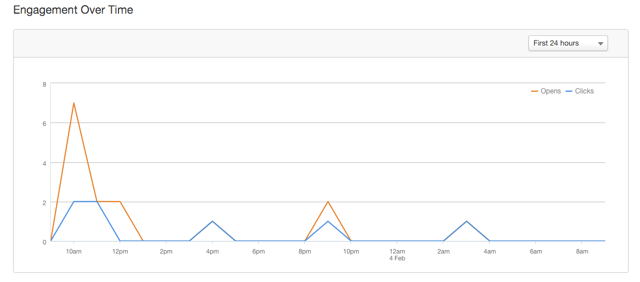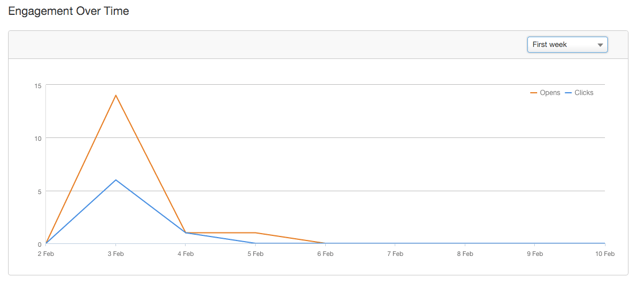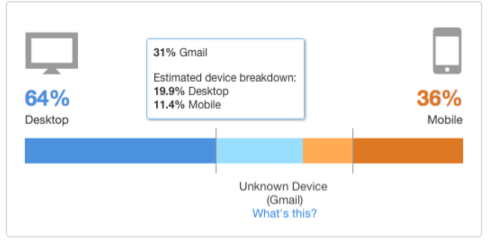 Your SME’s B2B email marketing efforts should be the definition of an inbound marketing success story; continually setting the standards of excellence for your industry. Why? Because email marketing isn’t just big, it’s “Huuuuge.” According to WebMarketing123, 66% of marketers say that email marketing is their top performing marketing channel.
Your SME’s B2B email marketing efforts should be the definition of an inbound marketing success story; continually setting the standards of excellence for your industry. Why? Because email marketing isn’t just big, it’s “Huuuuge.” According to WebMarketing123, 66% of marketers say that email marketing is their top performing marketing channel.
Regardless of overflowing email inboxes across the planet, don’t buy into the myth that “People are inundated with emails today, and they simply won’t read marketing emails.” It’s possible to get in front of the marketing noise with an email marketing message that reaches the right audience at the right time, increasing your ROI - but how?
Before you can determine how to increase your email marketing ROI, take a step back and assess if you’re currently achieving the results that you want. You’re probably not since you’re reading this blog, so what’s a B2B marketer to do? Is the answer to send more emails more often? Not necessarily - so don’t burn the midnight oil just yet crafting another “brilliant” email or zoning out on metrics that don’t help you take action.
To quote Donald Trump, “In the end, you’re measured not by how much you undertake but what you finally accomplish.”
Accomplishing More with Email Marketing
According to WebMarketing 123's 2015 State of Digital Marketing Report, 93% of B2B marketers use email marketing, and the majority identify email as the one channel where it’s easiest to prove ROI; and 31% agree that email marketing has the most positive impact on revenue. Proving ROI with email marketing is easy because of the widespread availability of metrics. But not all metrics are created equal, so I challenge you to review my list of the most important email marketing metrics and focus on the metrics that align with your email marketing strategy.
Do you want more leads? Do you want to inform and educate your audience? Do you want to renew relationships with existing clients? Do you want to introduce your offerings or enhance your brand and reputation? Do you want more sales? You can achieve all of the above and more when you regularly analyze the right email marketing metrics.
Say Goodbye to Open Rates
Before I get into what metrics you should be measuring, I want to point out that open rates don’t provide the insight that they used to. While saying goodbye may be a bit of an exaggeration, marketers can no longer look at email open rates as the holy grail of email performance. SilverPop said the average email open rate in the U.S. is 20.7% but the reality is that baseline doesn’t mean a whole lot because email open rates are now being scrutinized for their relevancy.
According to Developer Media, “Because of email client and Internet changes, one month’s metrics could differ wildly from another month’s metrics. Thus, when we try to compare apples to apples with a flawed metric like email open rates, the rapidly changing environment prevents us from focusing on variables that matter.”
To drive the point further that you cannot rely on open rates like you used to, COMM100 said, “It's a generally accepted metric in the email marketing world that email open rate reporting can be off from anywhere from 11% to 35%.” I don’t know any SME’s that can afford to have that type of variance in metrics and this stark reality also forced me to abandon my hyperfocus on click-to-open-rate (CTOR).
Why Open Rates are DOA
It was challenging for me to kick my open rate analyzing habit but I encourage you to do the same because it’s an unhealthy obsession that won’t help you improve email marketing ROI and here’s why:
Open rates aren’t counted unless a recipient opens the email and downloads the images. Some email clients block images, so even if the recipient opens the email it won’t be counted as an open. To complicate things further, email clients on mobile devices track opens differently.To boot, opens from text based emails will never count as an open. HTML code matters too, and according to Pardot, email opens won’t be tracked when emails are sent through an email plug-in, when emails are missing the </body> or </html> tag and emails without the </body> will have higher spam scores. Let’s break it down further:
- Incorrect attribution because some email clients automatically download email images which will count as an open even if the recipient never opens the email.
- Some emails are never opened because they get blocked, blacklisted, or deleted.
Can Open Rates Tell a Story?
When you identify emails that have good click-through-rates (CTR) and conversions you can take a look at the open rate of those emails to gain an understanding of what a good open rate looks like for your business. Take your target open rate and compare it to your email send time and day of the week.
If you send an email on Tuesday at 10 am and you have an open rate of 32%, and then you send an email on Wednesday at noon and have an 11% open rate, you should see a red flag that indicates you need to dig deeper and revisit your subject line, preview text and personalization. A/B testing subject lines is a great place to start.
Email Metrics that Matter
Now that I established why open rates are not an accurate measure of email marketing success, here is my list of important metrics you should base your review, analysis, and optimization on in order to improve your email marketing ROI:
- Click-through-rate (CTR) and Conversion Rate (CR): Are people taking action when they read your emails? According to SilverPop’s 2015 Email Marketing Metrics Benchmark Study, the average email CTR is 3%. The study dives further into CTR averages with a breakdown by industry. Make sure your emails have a CTA that drives people to your site or a landing page that has a conversion point. More and more emails are opened on mobile devices so make sure your email and landing page is responsive. For tips on how to improve your CTR, read 5 Ways to Improve Email Click Through Rates and for tips on how to improve your landing page conversion rates, check out 4 Insights to Increase Landing Page Conversion Rates.
- Email Engagement: Do you know how many people click your emails as time passes from your initial send? Do you know the devices people are using to open your emails? Do you know the rate of opens and clicks by device type? Below are engagement metrics reported in HubSpot for an email Imagine sent on Feb. 3rd at 10:04 am EST: You can see in the graph above the opens and clicks of this email within the first 24 hours. Our opens peaked with clicks on the initial send and at a much lower rate in the afternoon in evening. Look closely at the clicks around 4 pm and 3 am on 2/4/16, and you can see that no opens are associated with those clicks which is proof that open rate is not a reliable metric. Overall, this graph shows that recipients of this email were most engaged during the initial send within that first hour within the 24-hour window. We could test engagement levels by sending this email on a different day of the week or different time to see if we get more engagement.

You can see in the graph above the opens and clicks of this email within the first 24 hours. Our opens peaked with clicks on the initial send and at a much lower rate in the afternoon in evening. Look closely at the clicks around 4 pm and 3 am on 2/4/16, and you can see that no opens are associated with those clicks which is proof that open rate is not a reliable metric. Overall , this graph shows that recipients of this email were most engaged during the initial send within that first hour within the 24-hour window. We could test engagement levels by sending this email on a different day of the week or different time to see if we get more engagement.

Let’s take our review over time a step further by looking at engagement during the first week after an email send. The graph above is for the same email and shows that we had the most action on the day of send, very little action the day after and virtually no engagement the rest of that first week. You can also view engagement within the first month of an email send in HubSpot.

The graph above shows engagement by device type. Please keep in mind that HubSpot is not able to identify the device type of emails opened in Gmail, so they provide an estimate as for opens by device type shown in the example below for my email:

If you would like to learn more about how HubSpot calculates open metrics by device for Gmail, check out this blog. While it’s a bummer that we can’t see true Gmail engagement metrics by device, we can see that for my email example a majority of the opens are from desktop and all of the clicks are from desktop. Mobile shows 36% of opens which is a significant number and not completely accurate as I mentioned earlier in this blog. A red flag has been raised because while 36% (estimated) of opens are coming from mobile, we only see 14% of clicks coming from mobile devices. I will now have to go back and review the email for mobile devices again to test for the way the email rendered on multiple mobile devices to determine where the disconnect is from mobile opens to clicks.
Engagement rates should be reviewed for trends over time and can give you insight into best send dates and times and also indicate how recipients are interacting with your message on various devices. These insights will help you find ways to optimize your next email before you hit “send”.
3. Email Bounce Rates: Bounce rates are broken down into hard bounces and soft bounces and indicate that your emails aren’t reaching your audience. Hard bounces mean that you are using the wrong email for a contact and soft bounces mean that the receiving email server is having issues delivering your email. If your bounce rates are high, spend some time cleaning up your email lists. Over time, high bounce rates will increase how long it takes for your emails to get delivered and could negatively impact your email marketing reputation.
4. Email List Health: Is your email list growing? According to Marketing Sherpa, the average decay rate is 25% per year. Let’s say you start with a list of 1,000 in January, by the end of December your list will be down to 750. That should motivate you to spend some time every month doing some basic math to see where you stand. Here is a formula to help you calculate your email list decay rate:
(New Email Subscribers - (Opt-outs + Hard bounces))/Original List Size = Decay Rate
Here is an example of the formula using numbers based on an email list that started with 300 contacts, but now has 50 new subscribers, 4 opt-outs and 2 hard bounces. The decay rate ends up at 15% as shown here:
(50 - (4+1))/300 = (50-5)/300 = 45/300 = 15% Decay Rate
Once you measure your list size and decay rate for the month, dig deeper and take a look at your unsubscribes and the reason your are losing contacts; for example, is this dues to unsubscribes, hard bounces or spam? 
5. Delivery Rate: HubSpot recommends to aim for a delivery rate of 95% or higher. If you notice a decreasing delivery rate overtime, you need to revisit your email list because you probably have too many old emails on it. If you notice that an isolated email send had a lower delivery rate, take a look at the subject line and content and determine if any element may have raised a spam flag.
Putting the Numbers Together
Email optimization is the fastest way to improve marketing performance for B2B SME’s. But don’t get lost in metrics that don’t matter to your business. Take the first step by outlining your email marketing strategy and goals, then commit to reviewing your email marketing metrics at regular intervals so you can establish your company’s baseline and continue to move towards achieving your goals. Want more quality leads generated? Want more leads to turn to customers? Want improved revenue? Email marketing can do all of that and more. Get in the sandbox.

 Doug Davidoff
Doug Davidoff